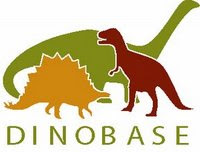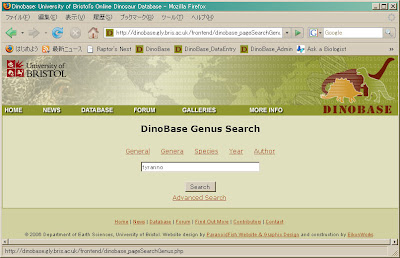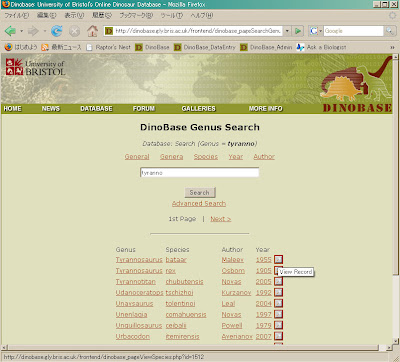 Well, it's almost a whole year since the launch of the new DinoBase. The actual one-year anniversary for the relaunch is the 17th of April (see here for my post on the launch day last year). I'm sure most of my readers are already aware, DinoBase is an online resource hosted by the Department of Earth Sciences, University of Bristol which I just happen to be the administrator of. The main feature of DinoBase is as the name suggests, its online database of dinosaurs. Visitors can search for dinosaurs using a number of search criteria such as genera, species, author, or year of description. I'll just go through the basic search function here.
Well, it's almost a whole year since the launch of the new DinoBase. The actual one-year anniversary for the relaunch is the 17th of April (see here for my post on the launch day last year). I'm sure most of my readers are already aware, DinoBase is an online resource hosted by the Department of Earth Sciences, University of Bristol which I just happen to be the administrator of. The main feature of DinoBase is as the name suggests, its online database of dinosaurs. Visitors can search for dinosaurs using a number of search criteria such as genera, species, author, or year of description. I'll just go through the basic search function here.Let's say we want to search for Tyrannosaurus rex but can't be bothered to spell out the whole name so we type in "tyranno".

Now we click on "search" and DinoBase will return the following list:

Note that DinoBase returns all records alphabetically, so the first few are the ones of interest, in this case, Tyrannosaurus bataar and Tyrannosaurus rex. Now to view the record we don't want to click on the dinosaur names because that will research the database under a new search criterion, i.e. the name you just clicked as the new keyword, so we want to click on the magnifying glass icon to the right of the names. When you place your cursor over it, a little pop-up comes up with "View Record".

Now we can view the information as a new window. Incidentally, Tyrannosaurus bataar is listed twice once as Tyrannosaurus and again as Tarbosaurus. This is due to a glitch in the system that doesn't let me delete entries so it stays for the moment. The only solution around this problem is to state its synonymous situation and redirect the user to the correct name, i.e. Tarbosaurus bataar, though I'm sure some people would prefer Tyrannosaurus bataar...
We do try to keep the information up to date as possible but currently there are only two of us doing data entry and management on the side (as we are both students) so there is a bit of a limit. New entries are stored on the waitlist until approved by myself - which is quite harsh as we need size data for taxa that is known from a single vertebra...so you can imagine why I'm reluctant to just approve every single new entry - I want to get as much as an accurate size estimate as possible, motly because information on DinoBase is supposed to be "academically approved".
Some of the entries will have pretty pictures like this one for T. rex. But a lot of them don't so if you're reading this and you're an active palaeoartist and want to use this chance to promote your dinosaur reconstructions, then please do contribute. We are always looking for good images of minor or rare dinosaurs!
Comments